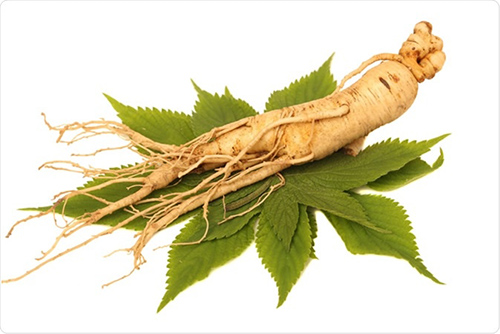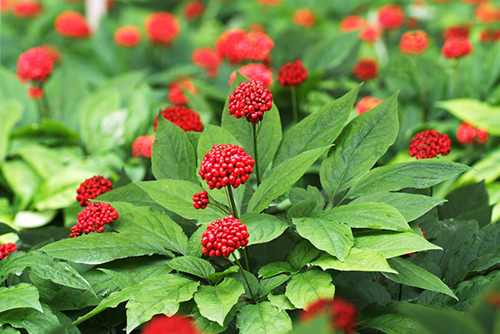This root has been continuously used for over four thousand years in China due to ginseng health benefits. It was introduced in Europe during the 18th century and has been the issue of many scientific studies due to its extraordinary merits.
- NooMost¡¯s unique formula combines the potency of Korean Ginseng extract with 10% Ginsenosides and the benefits of 60mg Ginko leaf extract. Our blend of Korean Red Ginseng & Gingo is specially designed to boost work performance in both men and women
- Offering a variety of benefits of Ginseng extract to business professionals, entrepreneurs, and students, our energy supplements NooMost have something to offer everyone. If you need to enhance your physical performance, strengthen your memory, or support your immune system, you will love Red Ginseng capsules NooMost formulated with Ginko biloba

Its scientific name, Panax, comes from the Greek words pan (all) and axos (healing). For Chinese people, ginseng health benefits are a real panacea that can heal many afflictions. Its aphrodisiac effects have given it wide popularity in Western countries, in which stress, tobacco, alcohol, and other drugs have become continuous aggression to sexual performance.
Ginseng Scientific Facts
- SCIENTIFIC SYNONYMS: Panax schinsegn Nees
- FRENCH: Ginseng
- SPANISH: Ginseng
- HABITAT: Native to mountainous and cold areas of Korea, China, and Japan, where it is widely cultivated
- DESCRIPTION: The plant of the Araliaceae family grows from 20 to 50 cm high. Its flowers grow in groups of five. It has purple flowers, which give birth to small fruits (berries). The root is fleshy, greyish or white, from 10 to 15 cm large, and an average of 200 g weight
- PARTS USED: The root after five years of age
WARNING: Excessive doses can produce nervousness. Do not associate it with coffee or tea, since it can produce nervous excitation, nor with medicines containing iron, because this mineral interferes chemically with the active components of ginseng, decreasing its effects.
Medicinal Properties

The active ingredients responsible for ginseng health benefits are so chemically complex that it has not been possible to synthesize them. They are called ginsenosides, and chemically, these are steroid glycosides from the group of triterpenic saponins.
Therapeutic properties of ginseng are due mainly to these substances but are also enhanced by other components: minerals and trace elements, the most outstanding being sulfur, manganese, germanium, magnesium, calcium, and zinc; vitamin B1, B2, B6, biotin, and pantothenic acid; phytosterol, enzymes, and other substances as well.
Ginseng Health Benefits
This herb has a wide range of effects on the body.
Invigorator
Ginsenosides increase physical performance and endurance. This is not due to any excitant properties, such as in cocaine, coffee, tea, or other drugs, but to an improvement of metabolic processes. Ginseng speeds up the enzymic process of glycogenesis (production of glycogen in the liver from sugar) and glycogenolysis (production of sugar from the stored glycogen); it decreases the concentration of lactic acid in muscles, which causes stiffness because of a better sugar metabolism; increases the production of ATP (adenosinetriphosphate), a substance of excellent energetic capabilities for cells; enhances the use of oxygen by cells; increases protein synthesis (anabolic effect); stimulates hematopoiesis (blood production) in the bone medulla, especially after bleeding.
All these biochemical effects have been experimentally proven. Therefore, ginseng invigorates but does not excite or provoke addiction since it increases cell energy production.

Nervous System
It has anti-depressive and anxiolytic properties (which eliminate anxiety). Ginseng promotes mental performance, increasing concentration and memory capabilities.
Endocrine System
Ginseng has antistress properties due to its “adaptogenic” properties because it increases the adaptation capabilities of the body to physical or psychological efforts. Research conducted on animals has proven that both hypophysis and suprarenal glands are stimulated with ginseng.
Cardiovascular System
Ginseng has vasoregulating properties, balancing blood pressure.
Reproductive System
Ginseng promotes spermatogenesis (increases the production of spermatozoids), stimulates sexual glands (both male and female), and increases hormone production; it increases sexual capability, improving both frequency and quality of male erection and promoting female genital organ excitation. It is not an actual aphrodisiac substance since its action does not involve arousing sexual desire but improving the function and capabilities of genitalia.
Other uses of Ginseng Include the Following:
- Physical exhaustion: Asthenia, easy fatigue, lack of energy, recovery from diseases or surgery
- Sports training: Ginseng is not on the list of banned substances in sports
- Stress, psychosomatic disorders: Gastritis, colitis, migraine, asthma, and palpitations
- Psychological exhaustion, depression, anxiety, insomnia: Ginseng is very helpful for students during examinations
- Premature aging, senility
- High or low blood pressure
- Anemia: Ginseng is especially useful for recovering blood loss after donation or bleeding
- Sexuality disorders: Impotence, female frigidity, hormonal insufficiency, male or female sterility
Ginseng is widely used for blood diseases, hemorrhages, feverish and inflammatory illnesses. Women use it for everything from easing childbirth to normalizing menstruation. It strengthens the reproductive and adrenal glands. It stimulates the appetite, enhances the immune system, promotes lung functioning, and helps digestive disturbances.
Ginseng is also mildly stimulating to the endocrine and central nervous system. It is helpful in stress, lack of energy, infertility, diabetes, and bronchitis. This herb’s medicinal properties also protect against radiation exposure and help with the symptoms of withdrawal from cocaine.
It is demulcent; therefore, hot ginseng tea is effective for coughs, chest troubles, and colds. It helps to reduce cholesterol, increase circulation, tone the heart, and normalize blood pressure. In addition, it is helpful to people with diabetes because it lowers blood sugar. Its many benefits also include the alleviation of anemia.
NOTE: Only use the roots when they are dried thoroughly. It is still a beneficial herb, though its value is highly overblown. Avoid taking it at night because of its ability to keep you awake. Chinese ginseng (Panax ginseng) is considered superior to the North American variety. However, American ginseng (Panax quinquefolius) is the same as the Chinese version. So much so that most of the American crop (grown under cultivation in Wisconsin) is exported to Asia and Europe to complement the supply from the Orient (most of which is produced in Korea).
Preparation and Dosage
Decoction: Simmer for fifteen to sixty minutes and use about ¼ ounces of the herb in one pint of water. Take four ounces three times a day. Tincture: twenty to sixty drops three times a day. Fluid Extract: ½ to two teaspoons three times daily. Powder: two to five #0 capsules (15 to 30 grains) thrice daily.
DISCLAIMER: All content on this website is presented solely for educational and informational objectives. You should not rely on the information provided as a replacement for advice, diagnosis, or treatment from a qualified medical expert. If you are pregnant, nursing, or have any preexisting medical concerns, you should talk to your doctor before using any herbal or natural medicines.
Types of Ginseng: There are Several Ginseng Varieties
- Red or Korean Ginseng: (Panax ginseng C. A. Meyer), the most famous ginseng and the richest in active components
- Chinese ginseng: (Panax repens Max.), which is cultivated in China and Southeast Asia
- American ginseng: (Panax quinquefolium L.), native to the northeastern United States and southeastern Canada. It grows wild in oak and beech tree forests
- Eleutherococcus: (Eleutherococcus senticosus Maxim.) Also called Russian or Siberian ginseng, it is cultivated with therapeutic goals and has properties similar to Korean ginseng.
REFERENCES
- George D. Pamplona-Roger, M.D. “Encyclopedia of Medicinal Plants.” George D. Pamplona-Roger, M.D. Encyclopedia of Medicinal Plants. Ed. Francesc X. Gelabert. vols. 2 San Fernando de Henares: Editorial Safeliz, 2000. 608, 609. Print. [ginseng health benefits]
- Vance Ferrell Harold M. Cherne, M.D. The Natural Remedies Encyclopedia [Book]. – Altamont, TN: Harvestime Books, 2010. – Vol. Seventh Edition: 7: pp. 160, 161.
- “Ginsenosides: Mechanisms of Action and Potential Applications” by Jae Hong Kim et al. in Journal of Ginseng Research (2008)
- “Chemistry and Pharmacology of Ginseng: Saponins as Major Active Constituents” by Atsushi Hasegawa et al. in Journal of Natural Products (1992)
- “Drug Interactions with Ginseng” by Michael W. Weaver in American Journal of Health-System Pharmacy (2000)
- “Herb-Drug Interactions: A Clinician’s Pocket Reference” by Elizabeth M. Williamson et al. (2014)
- “American ginseng: Pharmacology, Chemistry and Clinical Research” by Edzard Ernst in Journal of Ginseng Research (2010)
- “Comparative Analysis of Chemical Constituents and Effects of Panax Ginseng C.A. Meyer and Panax Quinquefolius L. Roots” by Hyun Ae Yoo et al. in Journal of Medicinal Food (2005)
- “The Use of Ginseng in the United States: Recommendations” by American Botanical Council (2013)
- “Herbal Medicines: Recommendations for Quality Assurance” by World Health Organization (2004)
- “The Culinary Uses of Ginseng” by Eric C. Lindstrom in Economic Botany (1997)
- “Ginseng: History, Botany, Applications and Cultivation” by Peter Hansel (2005)
- “Ginseng Safety Review” by Robert N. Upton and Steven F. Fibel in Drug Information Journal (2009)
- “American Ginseng (Panax Quinquefolius L.): A Systematic Review of Adverse Effects” by Michael J. Soo et al. in Phytomedicine (2017)
- “A Review of the Safety and Efficacy of Ginseng as a General Tonic for the Central Nervous System” by Sarah E. Barton et al. in Journal of Clinical Pharmacy and Therapeutics (2013)
- “Ginseng for Cognitive Function and Improvement: A Systematic Review” by Xiao-Ping He et al. in Journal of Ethnopharmacology (2017)
Last update on 2025-06-03 / Affiliate links / Images from Amazon Product Advertising API










